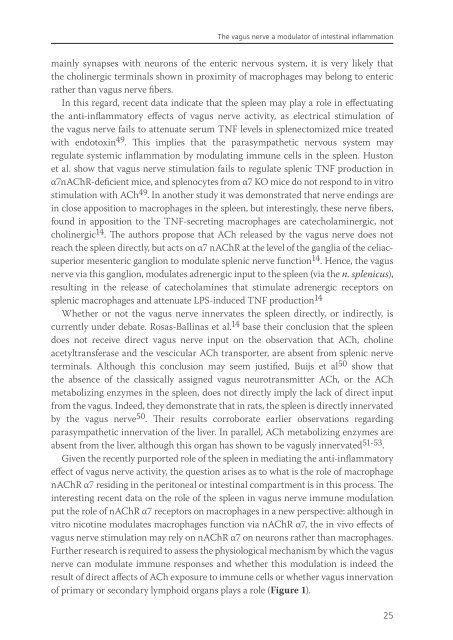The vagus nerve as a modulator of intestinal inflammation - TI Pharma
The vagus nerve as a modulator of intestinal inflammation - TI Pharma
The vagus nerve as a modulator of intestinal inflammation - TI Pharma
You also want an ePaper? Increase the reach of your titles
YUMPU automatically turns print PDFs into web optimized ePapers that Google loves.
<strong>The</strong> <strong>vagus</strong> <strong>nerve</strong> a <strong>modulator</strong> <strong>of</strong> <strong>intestinal</strong> <strong>inflammation</strong><br />
mainly synapses with neurons <strong>of</strong> the enteric nervous system, it is very likely that<br />
the cholinergic terminals shown in proximity <strong>of</strong> macrophages may belong to enteric<br />
rather than <strong>vagus</strong> <strong>nerve</strong> fibers.<br />
In this regard, recent data indicate that the spleen may play a role in effectuating<br />
the anti-inflammatory effects <strong>of</strong> <strong>vagus</strong> <strong>nerve</strong> activity, <strong>as</strong> electrical stimulation <strong>of</strong><br />
the <strong>vagus</strong> <strong>nerve</strong> fails to attenuate serum TNF levels in splenectomized mice treated<br />
with endotoxin 49 . This implies that the par<strong>as</strong>ympathetic nervous system may<br />
regulate systemic <strong>inflammation</strong> by modulating immune cells in the spleen. Huston<br />
et al. show that <strong>vagus</strong> <strong>nerve</strong> stimulation fails to regulate splenic TNF production in<br />
α7nAChR-deficient mice, and splenocytes from α7 KO mice do not respond to in vitro<br />
stimulation with ACh 49 . In another study it w<strong>as</strong> demonstrated that <strong>nerve</strong> endings are<br />
in close apposition to macrophages in the spleen, but interestingly, these <strong>nerve</strong> fibers,<br />
found in apposition to the TNF-secreting macrophages are catecholaminergic, not<br />
cholinergic 14 . <strong>The</strong> authors propose that ACh rele<strong>as</strong>ed by the <strong>vagus</strong> <strong>nerve</strong> does not<br />
reach the spleen directly, but acts on α7 nAChR at the level <strong>of</strong> the ganglia <strong>of</strong> the celiacsuperior<br />
mesenteric ganglion to modulate splenic <strong>nerve</strong> function 14 . Hence, the <strong>vagus</strong><br />
<strong>nerve</strong> via this ganglion, modulates adrenergic input to the spleen (via the n. splenicus),<br />
resulting in the rele<strong>as</strong>e <strong>of</strong> catecholamines that stimulate adrenergic receptors on<br />
splenic macrophages and attenuate LPS-induced TNF production 14<br />
Whether or not the <strong>vagus</strong> <strong>nerve</strong> innervates the spleen directly, or indirectly, is<br />
currently under debate. Ros<strong>as</strong>-Ballin<strong>as</strong> et al. 14 b<strong>as</strong>e their conclusion that the spleen<br />
does not receive direct <strong>vagus</strong> <strong>nerve</strong> input on the observation that ACh, choline<br />
acetyltransfer<strong>as</strong>e and the vescicular ACh transporter, are absent from splenic <strong>nerve</strong><br />
terminals. Although this conclusion may seem justified, Buijs et al 50 show that<br />
the absence <strong>of</strong> the cl<strong>as</strong>sically <strong>as</strong>signed <strong>vagus</strong> neurotransmitter ACh, or the ACh<br />
metabolizing enzymes in the spleen, does not directly imply the lack <strong>of</strong> direct input<br />
from the <strong>vagus</strong>. Indeed, they demonstrate that in rats, the spleen is directly innervated<br />
by the <strong>vagus</strong> <strong>nerve</strong> 50 . <strong>The</strong>ir results corroborate earlier observations regarding<br />
par<strong>as</strong>ympathetic innervation <strong>of</strong> the liver. In parallel, ACh metabolizing enzymes are<br />
absent from the liver, although this organ h<strong>as</strong> shown to be <strong>vagus</strong>ly innervated 51-53 .<br />
Given the recently purported role <strong>of</strong> the spleen in mediating the anti-inflammatory<br />
effect <strong>of</strong> <strong>vagus</strong> <strong>nerve</strong> activity, the question arises <strong>as</strong> to what is the role <strong>of</strong> macrophage<br />
nAChR α7 residing in the peritoneal or <strong>intestinal</strong> compartment is in this process. <strong>The</strong><br />
interesting recent data on the role <strong>of</strong> the spleen in <strong>vagus</strong> <strong>nerve</strong> immune modulation<br />
put the role <strong>of</strong> nAChR α7 receptors on macrophages in a new perspective: although in<br />
vitro nicotine modulates macrophages function via nAChR α7, the in vivo effects <strong>of</strong><br />
<strong>vagus</strong> <strong>nerve</strong> stimulation may rely on nAChR α7 on neurons rather than macrophages.<br />
Further research is required to <strong>as</strong>sess the physiological mechanism by which the <strong>vagus</strong><br />
<strong>nerve</strong> can modulate immune responses and whether this modulation is indeed the<br />
result <strong>of</strong> direct affects <strong>of</strong> ACh exposure to immune cells or whether <strong>vagus</strong> innervation<br />
<strong>of</strong> primary or secondary lymphoid organs plays a role (Figure 1).<br />
25













